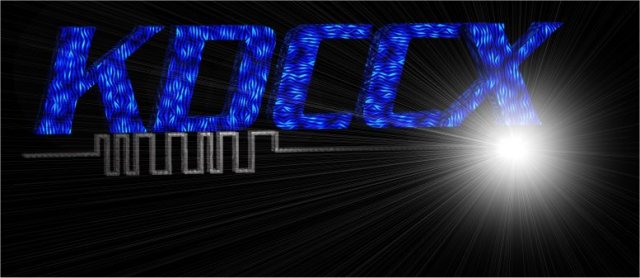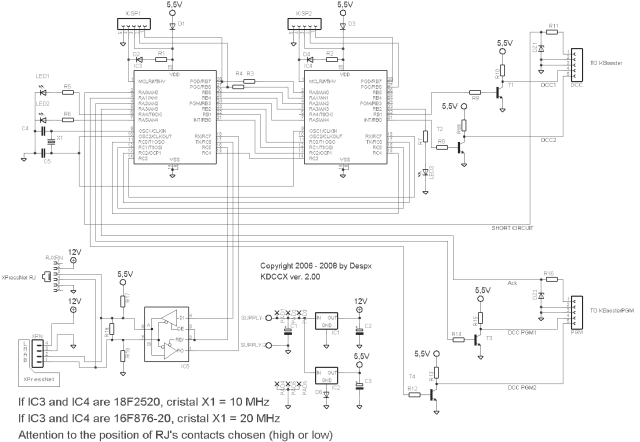Tutto il materiale pubbilcato
in questa pagina è protetto da Copyright e non
può essere pubblicato o linkato interamente o
in parte ne usato per fini di lucro senza il permesso
dell'autore
All
material published on this page is protected by copyright
and can not be published or linked in whole or in part
and used for commercial gain without the author's permission
 

After about two years
and two beta versions, I will present you KDCCX!

KDCCX is the
evolution of the old KDCC in new system were brought
(and come in future) all the new technologies of the
DCC and XpressNet.
COMPUTING POWER
KDCCX is designed
for the future as it is born fully multitasking biprocessore
fact, unlike other projects in the web, it presents
solutions nearest to a PC that a simple card with a
PIC16F628 who usually do everything with little performance.
KDCCX have two microprocessors PIC18F2520 (future
versions will be provided with the PIC18F2620 and PIC16F876
in this case will be limited) who works with a single
10MHz clock that is multiplied x4 to obtain an internal
frequency of 40MHz, this speed, combined with a program
memory of 32 KByte and a RAM of 1536 KByte (per processor),
guarantees plenty of memory for future software upgrade.
The concept of biprocessore, already adopted by
KDCC proved to be a good choice because it allows for
100% of a processor dedicated to a single task playing
in the best possible. KDCCX provides the interface XpressNet
with a PIC18F2520 and the other PIC dedicated to the
generation of DCC signa, the two chips are connected
by a fast parallel bus 8bit for data + 4-bit addresses.
SCHEME:

PCB and
Firmwares
The pdf's
files of PCB top - PCB bottom and the mircochips's firmwares
ar aviable in Download page.
MODULARITY
KDCCX is also
modular in design, I have given that the plant could
adapt to the tastes of the user.
The first characteristic
that makes KDCCX modular architecture is a dual processor
fact, if you only want a CV program station (reading
and writing CV), you only mount a single IC3.
The
second characteristic is that the system’s pcb (10cm
x 10cm) was designed to connect other expansion’s
fauters :
-Power-booster
-Booster for
programming
-Expansion for RJ11 connectors
-RF modules
-RailCom
-form rectification and
filtering loss of power
-etc ...
These
expansions will be available in future and may be connected
to KDCCX simply stacking one on top and connecting them
through connections provided in the project.
Once
complete, the plant will be a cube power!
Obviously
the user will be according to your needs to decide what
to connect KDCC!
AT THIS
TIME
At this time,
what can offer KDCCX?
Software:
-It can simultaneously
control 40 locomotives (only 12 with 16F876) with addresses
from 1 to 9999 without the defect of the
XpressNet protocol 99-127*
-It
can control 1024 turnouts and signals (from firmware
ver. 024 above)
-It can handle
all 31 addresses XpressNet
-Supports
any device that supports the protocol XpressNet (Lokmaus,
Multimaus, etc.).
-Read and
writes CV in DIRECT MODE
-Write CV
in POM (Program On the Main)
-Supports
28 and 128 speed step
-FL (lights)
and F1 through F12
-Ready to
RailCom Cutout (as soon as his booster will be aviable)
Hardware:
>>>>>>>>>>>>>>>>>>>>>>
Mettere il Pdf del pcb <<<<<<<<<<<<<<<<<<<<<
-ICSP connectors
on board for each microprocessor you can program them
without extract from card.
-Supply for
separate hardware card and bus Xpressnet
-two DCC’s
signals phased
for external Booster drive to bridge H
-Input
signal short-circuit and ACK overvoltage protected (voltage
applied from 3 volts to 24 volts)
-RJ11
female connector on board XpressNet
-Connector
with signals XpressNet, 12 volt and mass.
-Indicator
light (LED) to the central government.
99-127
* The protocol XpressNet presents an anomaly
in the management of addresses.
From 1 to 99 XpressNet
identifies such values as "short address"
(CV1) instead from 100 until 9999 as "long address"
(CV17 and CV18). This address management creates compatibility
problems between central and decoder, in fact all decoders
below the standard NMRA identify as "short address"
the values of 1 to 127 and "long address” from
128, how can we understand there’s a discrepancy of
28 addresses between XpressNet and NMRA, this anomaly
is reflected in an apparent malfunction of the decoder
with short addresses between 100 and 127, because the
decoder expect the command and instead receive others
that can not process and therefore do not perform. KDCCX
solves this problem by analyzing the XpressNet’s commands
before sending to the decoder and, where necessary,
it corrects the error without the user notice!
|